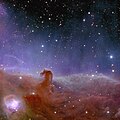Barkas:Euclid’s view of the Horsehead Nebula ESA25170866.jpg

Berkas asli (8.200 × 8.200 piksel, ukuran barkas: 1,84 MB, jinis MIME: image/jpeg)
Barkas iki saka Wikimedia Commons lan kena kanggo proyèk liya. Panyandraning kaca panyandra barkasé kapacak ing ngisor.
Ringkesan
| PanyandraEuclid’s view of the Horsehead Nebula ESA25170866.jpg |
English: Euclid shows us a spectacularly panoramic and detailed view of the Horsehead Nebula, also known as Barnard 33 and part of the constellation Orion.
At approximately 1375 light-years away, the Horsehead—visible as a dark cloud shaped like a horse’s head—is the closest giant star-forming region to Earth. It sits just to the south of star Alnitak, the easternmost of Orion’s famous three-star belt, and is part of the vast Orion molecular cloud. [Image description: This square astronomical image is divided horizontally by a waving line between a white-orange cloudscape forming a nebula along the bottom portion and a comparatively blue-purple-pink upper portion. From the nebula in the bottom half of the image, an orange cloud shaped like a horsehead sticks out. In the bottom left of the image, a white round glow is visible. The clouds from the bottom half of the image shine purple/blue light into the upper half. The top of the image shows the black expanse of space. Speckled across both portions is a starfield, showing stars of varying sizes and colours. Blue stars are younger and red stars are older.] Tiếng Việt: Tinh vân Đầu Ngựa, còn được gọi là Barnard 33 và là một phần của chòm sao Orion |
| Tanggal | 7 Novèmber 2023 (upload date) |
| Sumber | Euclid’s view of the Horsehead Nebula |
| Juru pangarang | ESA/Euclid/Euclid Consortium/NASA image processing by J.-C. Cuillandre (CEA Paris-Saclay) G. Anselmi |
| Vèrsi liya |
|
| Activity InfoField | Space Science |
| Keyword InfoField | Horsehead Nebula Stars |
| Mission InfoField | Euclid |
| Set InfoField | Euclid First Images |
|

|
This image was selected as picture of the day on Vietnamese Wikipedia.
|
Lisènsi
This media was created by the European Space Agency (ESA).
Where expressly so stated, images or videos are covered by the Creative Commons Attribution-ShareAlike 3.0 IGO (CC BY-SA 3.0 IGO) licence, ESA being an Intergovernmental Organisation (IGO), as defined by the CC BY-SA 3.0 IGO licence. The user is allowed under the terms and conditions of the CC BY-SA 3.0 IGO license to Reproduce, Distribute and Publicly Perform the ESA images and videos released under CC BY-SA 3.0 IGO licence and the Adaptations thereof, without further explicit permission being necessary, for as long as the user complies with the conditions and restrictions set forth in the CC BY-SA 3.0 IGO licence, these including that:
See the ESA Creative Commons copyright notice for complete information, and this article for additional details.
|
 | |
Berkas ini dilisensikan di bawah lisensi Creative Commons Atribusi-Berbagi Serupa 3.0 IGO. Atribusi: ESA/Euclid/Euclid Consortium/NASA, image processing by J.-C. Cuillandre (CEA Paris-Saclay), G. Anselmi, CC BY-SA IGO 3.0
| ||
Berkas ini sebelumnya diunggah ke Euclid’s view of the Horsehead Nebula dan ditinjau pada tanggal 13 November 2023 oleh pengguna peninjau yaitu Юрий Д.К. yang mengonfirmasi bahwa pada tanggal tersebut berkas ini betul memiliki lisensi sesuai yang dinyatakan.
|
Captions
Items portrayed in this file
gegambaran
Nebula Kepala Kuda Indonesia
status hak cipta Indonesia
berhak cipta Indonesia
lisensi Indonesia
tipe media Indonesia
image/jpeg
tinggi Indonesia
8.200 piksel
lebar Indonesia
8.200 piksel
ukuran data Indonesia
1.925.643 Bita
checksum Inggris
c128318f38ea88c7da0a62dc209a407e6cf41e26
sejak Indonesia
7 Novèmber 2023
sumber berkas Indonesia
file available on the internet Inggris
pHash checksum Inggris
5qju5gik7a1tmf81iz4c7n0btv09ef7iz94girulklo143cu3c
asesmen kualitas Commons Indonesia
gambar pilihan Wikimedia Commons Indonesia
Sajarahing berkas
Klik ing tanggal/wektuné saprelu ndeleng rupané barkasé nalika tanggal iku.
| Tanggal/Wektu | Gambar cilik | Alang ujur | Naraguna | Tanggepan | |
|---|---|---|---|---|---|
| saiki | 7 Novèmber 2023 18.50 |  | 8.200 × 8.200 (1,84 MB) | OptimusPrimeBot | #Spacemedia - Upload of https://www.esa.int/var/esa/storage/images/esa_multimedia/images/2023/11/euclid_s_view_of_the_horsehead_nebula/25170855-1-eng-GB/Euclid_s_view_of_the_Horsehead_Nebula.jpg via Commons:Spacemedia |
Panggunaning berkas
Ora ana kaca kang nganggo barkas iki.
Panggunané barkas sajagat
Wiki liya ngisor iki nganggo barkas iki:
- Kanggo ing fr.wikipedia.org
- Kanggo ing he.wikipedia.org
- Kanggo ing ru.wikipedia.org
- Kanggo ing vi.wikipedia.org
Métadhatah
Barkas iki ngemu katerangan tambahan, bokmanawa asalé saka kodhak dhigital utawa sekèner kang dienggo metha utawa ndhigitalisasi barkas iku.
Yèn barkasé wis diowahi saka asliné, sawenèh rerincèn mungkin ora sawutuhé mèmper karo barkas owahané.
| Komposisi piksel | RGB |
|---|---|
| Sesirah gambar |
|
| Kéblat | Sedhengan |
| Résolusi horisontal | 1 dpi |
| Résolusi vèrtikal | 1 dpi |
| Piranti alus kang kaanggo | GIMP 2.10.18 |
| Tanggal lan wektu owahé barkas | 29 Oktober 2023 09.54 |
| Tanggal lan wektu turuné dhata | 29 Oktober 2023 00.00 |
| ID unik dokumèn asli | xmp.did:93eb5251-7bdb-4a71-84ac-e2d7aedbd77e |
| Vèrsi IIM | 2 |



